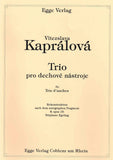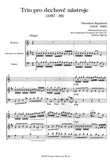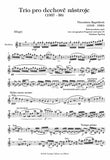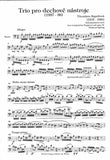Trio (score & parts) - OB/CL/BSN
Composer: Kapralova, Vitezslava
Publisher: Egge Verlag Coblenz
Edition: 60347
$42.95
Trio d'Anches
for oboe, clarinet, and bassoon
by Vitezslava Kapralova (1915-1940) - Czech composer and conductor
When Kapralova first met Bohuslav Martinu in Prague, in 1937, he would have certainly told her of his latest compositions, including "Quatre Madrigaux" which would soon be premiered. We can surmise that Kapralova began her reed trio in the hope of getting it performed by the famous "Trio d'anches de Paris". It would certainly also be broadcast on the radio and recorded on shellac 78s- for a young composer the brightest prospects! Why she ceased work on her trio after February 1938 can only be answered by vague assumptions. The most probably cause is that 1938 brought so much work with the move to Paris, her scholarship ad her Military Sinfonietta (which she conducted in performance in Prague and London) that no time was left over for her trio.
This is a reconstruction after the autograph. To make the trio more than three minutes long, the editor has added two more movements to the completed first movement. From the Prague-composed "April Preludes" for piano, two of the latter's movements have been arranged for reed rio. Stylistically and motivically, these two movements are very similar to the original Trio movement, so a homogenous, novel, and independent work has been produced. Edited by Stephane Egeling, 2011.
for oboe, clarinet, and bassoon
by Vitezslava Kapralova (1915-1940) - Czech composer and conductor
I. Allegro
II. Andante semplice
III. Vivo
In December 1937, Kapralova began the composition of her reed trio. What led her to this combination is not known, though it can be presumed that Ferroud has strongly promoted the genre in Prague. Two further Prague composers also followed his lead, isa Krejci in 1935, and Klement Slavicky in 1937. Both wrote reed trios that were also performed on the radio. Isa Krejci had hidden a secret homage to Ferroud's "Triton" chamber music society in his trio: the work, based on a motif of a fourth, opens its first movement with a tritone, presented in unison. When Kapralova first met Bohuslav Martinu in Prague, in 1937, he would have certainly told her of his latest compositions, including "Quatre Madrigaux" which would soon be premiered. We can surmise that Kapralova began her reed trio in the hope of getting it performed by the famous "Trio d'anches de Paris". It would certainly also be broadcast on the radio and recorded on shellac 78s- for a young composer the brightest prospects! Why she ceased work on her trio after February 1938 can only be answered by vague assumptions. The most probably cause is that 1938 brought so much work with the move to Paris, her scholarship ad her Military Sinfonietta (which she conducted in performance in Prague and London) that no time was left over for her trio.
This is a reconstruction after the autograph. To make the trio more than three minutes long, the editor has added two more movements to the completed first movement. From the Prague-composed "April Preludes" for piano, two of the latter's movements have been arranged for reed rio. Stylistically and motivically, these two movements are very similar to the original Trio movement, so a homogenous, novel, and independent work has been produced. Edited by Stephane Egeling, 2011.









Share this item: